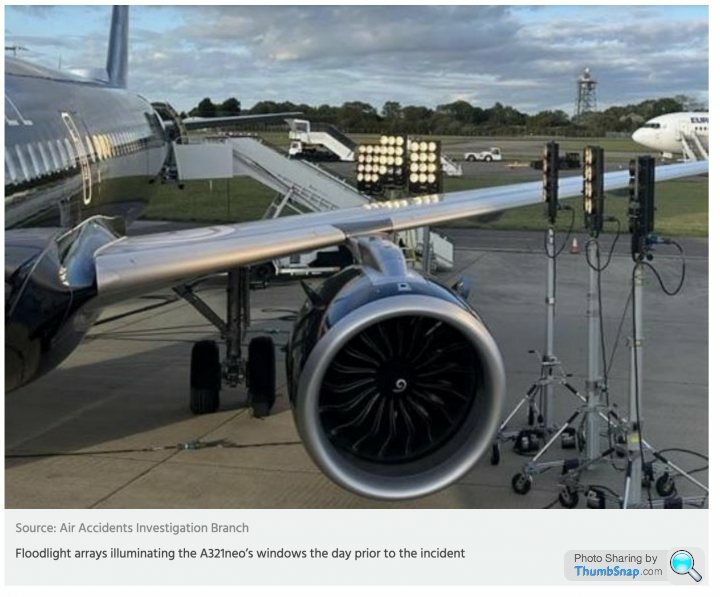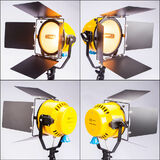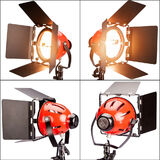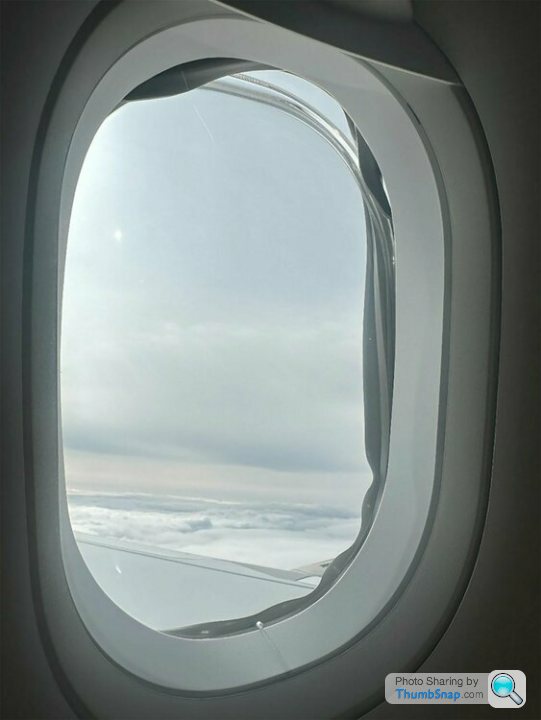Titan A321NEO windows departure cause
Discussion
The recent Titan A321NEO incident has a pretty extraordinary cause:

"Investigators believe intense heat from film floodlights concentrated on the exterior of an Airbus A321neo caused the aircraft’s windows to suffer thermal damage, before a number of window panes fell from the jet during a flight from London Stansted."
They should have been placed 10m away from the fuselage but were placed at more like 6m as they were simulating a sunrise for 4 hours filming:

Quite a few holes in that cheese.

"Investigators believe intense heat from film floodlights concentrated on the exterior of an Airbus A321neo caused the aircraft’s windows to suffer thermal damage, before a number of window panes fell from the jet during a flight from London Stansted."
They should have been placed 10m away from the fuselage but were placed at more like 6m as they were simulating a sunrise for 4 hours filming:

Quite a few holes in that cheese.
The heat from those lamps is incredible. I have worked on film sets and you can be in a massive sound stage early doors which is at 3-4c and literally freezing cold and after a full day the air temp can be into the 30c range.
We used plastics on the sets we build and it was quite common to have issues with the heat and the plastic.
Then add into the mix that those lamps can be focused quite tightly into one place and you could easily have a problem.
Just my 2ps worth.
We used plastics on the sets we build and it was quite common to have issues with the heat and the plastic.
Then add into the mix that those lamps can be focused quite tightly into one place and you could easily have a problem.
Just my 2ps worth.
gotoPzero said:
The heat from those lamps is incredible. I have worked on film sets and you can be in a massive sound stage early doors which is at 3-4c and literally freezing cold and after a full day the air temp can be into the 30c range.
I hope 30C doesn't make aeroplane windows fall out! And is the sound stage enclosed? In the above scenario it's open air so there's only radiation not convection/conduction. But the lights are pointing directly at the affected windows.I'm surprised they don't use LED lights - lighter, less power and a tiny fraction of the heat.
Simpo Two said:
gotoPzero said:
The heat from those lamps is incredible. I have worked on film sets and you can be in a massive sound stage early doors which is at 3-4c and literally freezing cold and after a full day the air temp can be into the 30c range.
I hope 30C doesn't make aeroplane windows fall out! And is the sound stage enclosed? In the above scenario it's open air so there's only radiation not convection/conduction. But the lights are pointing directly at the affected windows.I'm surprised they don't use LED lights - lighter, less power and a tiny fraction of the heat.
I don't know what spec the lights are. If you stand in front of them at full power its like opening your oven door at max heat.
I suspect with this particular aircraft the colour of the fuse did not help! Looks to me like they were trying to get the light through the windows so would have had it focused quite tight,.
Simpo Two said:
gotoPzero said:
The heat from those lamps is incredible. I have worked on film sets and you can be in a massive sound stage early doors which is at 3-4c and literally freezing cold and after a full day the air temp can be into the 30c range.
I hope 30C doesn't make aeroplane windows fall out! And is the sound stage enclosed? In the above scenario it's open air so there's only radiation not convection/conduction. But the lights are pointing directly at the affected windows.I'm surprised they don't use LED lights - lighter, less power and a tiny fraction of the heat.
gotoPzero said:
I suspect with this particular aircraft the colour of the fuse did not help! Looks to me like they were trying to get the light through the windows so would have had it focused quite tight,.
Oddly enough a few years ago I had to light an aeroplane to simulate a setting sun. But it was a mock-up in a garage and a single blonde about six feet away did the trick 
Gary C said:
dvs_dave said:
Simpo Two said:
Oddly enough a few years ago I had to light an aeroplane to simulate a setting sun. But it was a mock-up in a garage and a single blonde about six feet away did the trick 
Sounds like a dodgy porno filmset….
Yertis said:
Gary C said:
dvs_dave said:
Simpo Two said:
Oddly enough a few years ago I had to light an aeroplane to simulate a setting sun. But it was a mock-up in a garage and a single blonde about six feet away did the trick 
Sounds like a dodgy porno filmset….
Blonde

Redhead

Mr Pointy said:
Yertis said:
Gary C said:
dvs_dave said:
Simpo Two said:
Oddly enough a few years ago I had to light an aeroplane to simulate a setting sun. But it was a mock-up in a garage and a single blonde about six feet away did the trick 
Sounds like a dodgy porno filmset….
Blonde

Redhead


Yertis said:
This thread has become more interesting and more useless, without more pictures.

Thanks to Mr Pointy for filling in the technical bits!
The lights seem the obvious cause, but I'm surprised that being outdoors and the inverse square law didn't mitigate the effect.
The film company may be getting a bill...
Simpo Two said:
The film company may be getting a bill...
TBH, its the airline's responsibility to ensure anything happening in/around their aircraft - maintenance, ground handling etc is being done in accordance with proper procedures. I doubt very much though if there is any specific guidance in the Airbus manuals around filming with heat generating lamps. There's probably vague stuff about skin temperature hot spots and someone should have done a risk assessment but like I said originally, holes lining up in the cheese. The cost will be covered by insurance.Speed 3 said:
The recent Titan A321NEO incident has a pretty extraordinary cause:

"Investigators believe intense heat from film floodlights concentrated on the exterior of an Airbus A321neo caused the aircraft’s windows to suffer thermal damage, before a number of window panes fell from the jet during a flight from London Stansted."
They should have been placed 10m away from the fuselage but were placed at more like 6m as they were simulating a sunrise for 4 hours filming:

Quite a few holes in that cheese.
Utter b
"Investigators believe intense heat from film floodlights concentrated on the exterior of an Airbus A321neo caused the aircraft’s windows to suffer thermal damage, before a number of window panes fell from the jet during a flight from London Stansted."
They should have been placed 10m away from the fuselage but were placed at more like 6m as they were simulating a sunrise for 4 hours filming:

Quite a few holes in that cheese.
 ks. No way some lamps caused that to happen.
ks. No way some lamps caused that to happen. I remember working Nimrod R1 out of Seeb, went to put power on one lunchtime, thought I would check the internal temperature as I was sweating my arse off within 20 seconds of walking the length of the aircraft and connecting the batteries. The gauges read to 60°C if I remember correctly and were stuck on the stops.
It was over 50°C out on the pan and an aircraft locked up is like a giant oven.
The glass on the outside was that hot you couldn’t touch it we would normally clean the windows on a BF but they were so hot they were getting cleaned the night before on an AF and just left.
No way does a lamp damage a window from that distance away.
MB140 said:
Speed 3 said:
The recent Titan A321NEO incident has a pretty extraordinary cause:

"Investigators believe intense heat from film floodlights concentrated on the exterior of an Airbus A321neo caused the aircraft’s windows to suffer thermal damage, before a number of window panes fell from the jet during a flight from London Stansted."
They should have been placed 10m away from the fuselage but were placed at more like 6m as they were simulating a sunrise for 4 hours filming:

Quite a few holes in that cheese.
Utter b
"Investigators believe intense heat from film floodlights concentrated on the exterior of an Airbus A321neo caused the aircraft’s windows to suffer thermal damage, before a number of window panes fell from the jet during a flight from London Stansted."
They should have been placed 10m away from the fuselage but were placed at more like 6m as they were simulating a sunrise for 4 hours filming:

Quite a few holes in that cheese.
 ks. No way some lamps caused that to happen.
ks. No way some lamps caused that to happen. I remember working Nimrod R1 out of Seeb, went to put power on one lunchtime, thought I would check the internal temperature as I was sweating my arse off within 20 seconds of walking the length of the aircraft and connecting the batteries. The gauges read to 60°C if I remember correctly and were stuck on the stops.
It was over 50°C out on the pan and an aircraft locked up is like a giant oven.
The glass on the outside was that hot you couldn’t touch it we would normally clean the windows on a BF but they were so hot they were getting cleaned the night before on an AF and just left.
No way does a lamp damage a window from that distance away.
Please excuse me as I'm a layman, but wouldn't the fuselage distort before the glass under heat?. From a pic I found on t'web, it seems the glass is OK, but the rubber seal is distorted.
I'm not going to argue with the findings of course, but I'm intrigued as to which "gave out" first, the glass or the metal?.

I'm not going to argue with the findings of course, but I'm intrigued as to which "gave out" first, the glass or the metal?.

texaxile said:
I'm not going to argue with the findings of course, but I'm intrigued as to which "gave out" first, the glass or the metal?.
I would suggest (c) the rubber - or possibly adhesive holding bits together.NB That window looks designed to blow out; I'd have thought it would be fitted from inside so cabin pressure helps to hold it in place.
Edited by Simpo Two on Saturday 11th November 20:13
Gassing Station | Boats, Planes & Trains | Top of Page | What's New | My Stuff



